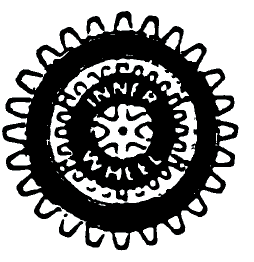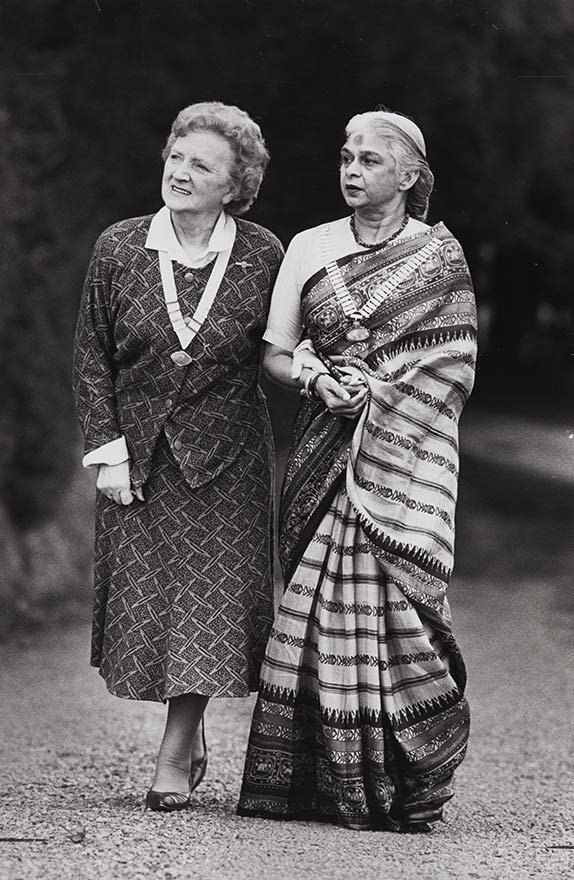
Inner Wheel New Zealand
1936 –
Theme: Service
Known as:
- Association of Inner Wheel Clubs of Great Britain and Ireland
1936 – 1947 - Association of Inner Wheel Clubs
1947 – 1967 - International Inner Wheel
1967 – 1990 - Inner Wheel New Zealand
1990 –
This essay written by Diana Beaglehole was first published in Women Together: a History of Women's Organisations in New Zealand in 1993. It was updated by Annabelle Valentine in 2018.
1936–1993
In 1993 the Inner Wheel Clubs of New Zealand comprised one of this country's largest service organisations for women, though they were also one of the least known. The organisation had three objects: to promote true friendship, to encourage the ideals of personal service, and to foster international understanding. It operated at club, district and national level, and was part of a world-wide organisation, the International Inner Wheel Movement, which had its own Governing Body and non-governmental representation at the United Nations. By 1992 there were 2500 members in New Zealand; international membership was 100,747 in 84 countries.
Rotary, which began in the USA in 1910 and became an international organisation in 1922, had not admitted female members. The first Inner Wheel club was formed by the wives of Rotarians in Manchester, England, in January 1924. Women in other parts of England soon followed suit, and in 1928 decided to group the early clubs into the first district. The growth of clubs throughout Britain led to further districts forming, and in 1934 these joined to form the Association of Inner Wheel Clubs of Great Britain and Ireland. Membership was open to wives or widows of Rotarians, and one close female relative of a Rotarian bachelor or widower could also belong. [1]
Laura Holland of Napier became interested in the movement while accompanying her husband to a Rotary conference in Scandinavia. New Zealand's first club was formed in Napier at a meeting she called on 27 November 1936. From the beginning, members were involved in helping various charities with donations and practical assistance. During the war years they joined the Red Cross as a unit, making hundreds of garments which were sent to England. They also entertained sailors from visiting Merchant Navy ships, and raised money to buy provisions for New Zealanders serving overseas.
The Napier club received its charter in 1946, becoming the tenth registered club outside Britain. In 1947 the words 'in Great Britain and Ireland' were removed from the title of the association, and overseas clubs were invited to become full members (though they still paid no dues and had no vote). That year the second New Zealand club was formed in Taumaranui, followed by Fitzroy (New Plymouth) and Christchurch South in 1963. From 1962, overseas clubs could be represented on the Governing Body of the movement, and in 1967 the name changed to International Inner Wheel. Rapid growth in New Zealand followed, especially in the South Island, where 29 clubs were chartered between 1969 and 1976. By 1980 the South Island had 32 clubs and the North Island 24.
Although a few clubs went into recess, and several amalgamated, there was a steady increase after 1980: by 1992 there were 81 clubs in New Zealand, plus one in Noumea, grouped in five districts. [2] The first conference was held at Fitzroy in 1969; in 1990 it was decided to form a National Council, and in 1992 the first national conference, held in Palmerston North, decided to issue a magazine.

Alexander Turnbull Library,Dominion Post, PAColl-7327-1-034-5019./p>
World Inner Wheel leader, Mrs Kapur, accompanied on her 1986 tour of New Zealand by Te Awamutu Inner Wheel member, Evelyn Laird, 1986.
Despite its restricted membership, the movement gave many New Zealand women the opportunity to take part in activities from club to international level. Eleven held seats on the governing body; Ruth Gallagher of Christchurch South was the first, serving from 1973 to 1975. In 1988–89, Alison Dowson of Christchurch served as international president.
Clubs met once a month, usually in the evening, with a visiting speaker; many also arranged a wide range of outings and social functions. The annual subscription covered club running costs, district dues and a capitation fee to international headquarters in England.
Each club ran its own local projects: in the main these involved helping groups such as the elderly, the needy, the young, and the ill or disabled, through means such as baking, handwork, dinners, contests and raffles. In 1992, for example, eighteen members of the Christchurch club made 405 dozen lamingtons for sale; the proceeds purchased a washing-machine for the local South Island Bone Marrow Trust family hostel. Often local Rotary projects were supported, and by the 1990s assistance to foodbanks featured prominently. Clubs were also involved with their district's international project, usually concerned with the Pacific region. As the objects of the movement suggest, the friends made and companionship gained through membership were as important as service to others.
Diana Beaglehole
1994–2018
Following the creation of Inner Wheel New Zealand (IWNZ) in 1990, which brought together all the Clubs in New Zealand and the Pacific Islands, there were many changes both nationally and internationally. Clubs continued to support not only their own local projects, but also national and international ones. Money and goods were given to both Christchurch and Kaikoura following their disastrous earthquakes, and IWNZ was presented with a Christchurch City Council award recognising the acts of kindness, service and heroism during and following the Christchurch earthquakes. Donations were sent to Australia to help with the Victoria bushfires and Eastern Seaboard floods, to Fiji after cyclones and floods, and to the Bayly Trust, which helps the poorest of the poor in Fiji. Money and aid were sent to the Boxing Day Tsunami appeal, Typhoon Haiyan (Yolanda) in the Philippines, and the Vanuatu Cyclone Pam appeal, as well as other areas of need.
IWNZ supported International Inner Wheel (IIW) projects for the Maternal and Neo-natal Tetanus Project, and for Girls’ Education in Laos, by donating money to build wells so that girls would be able to attend school, and no longer had to walk long distances to collect water. In 2012 it was decided at the Istanbul Convention that ‘Happier Futures’ would be the umbrella for fundraising worldwide, with the emphasis on helping to improve children’s lives. In 2018 the focus was changed to ‘Caring for Women and Girls’.
The five local districts all had their own projects in addition to their local club projects. In 2016, Look Good Feel Better, helping women recovering from cancer treatment, was chosen as the long term national project. IIW had NGO status at the United Nations and was an Observer on the Roster with consultative status. IWNZ’s four representatives followed and assisted the work sessions of the commissions on Human Rights, Rights of Children, Status of Women, The Family, The Elderly, and Narcotic Drugs, and reported to IIW on their activities. In turn IIW reported to the UN on Inner Wheel activities. Copies of the annual service reports from each country were sent to the UN representatives to keep them informed about the work of club members.
By 2018, websites, Facebook pages and Gmail accounts were all helping to keep members informed of what was happening in New Zealand and internationally. National conferences were held every two years in different parts of New Zealand, giving clubs an opportunity to showcase their district to other members. Members also attended the IIW triennial conventions, held in a different country each time; the 2006 convention was hosted by IWNZ in Christchurch.
Like so many service clubs, membership numbers were an ongoing concern. IWNZ membership had continued to increase from 1994 to 2006. However, longstanding members were ageing, more women were entering full time employment, and Rotary clubs – once the main source of IWNZ members, as Rotarians’ female relatives joined – had been admitting women since 1989. As a result, IWNZ started to see a decline in membership. The 2012 IIW Convention in Istanbul brought a landmark change, with the passing of a proposal to allow women with no Inner Wheel or Rotary connection to join. Coupled with the drive for younger new generation clubs, this helped with gaining new members; but because of their ageing membership, many clubs closed. Moreover, ageing combined with younger women’s shortage of time meant that finding members willing to take on positions of responsibility became more difficult. In 2010 the national president’s term changed from two years to one, and many clubs recycled presidents.
Despite these difficulties, members’ enthusiasm for giving service and creating friendships did not decrease, and by 2018 clubs were helping and supporting more people and organisations than ever before. IIW was by then one of the largest non-denominational women’s service organisations in the world, and total membership was growing worldwide.
At international level, IWNZ had been represented by an elected IIW Board Director since 1973. By 2018, two International Editors and an International Constitution Chairman had also come from New Zealand, as had two more International Presidents: Beth McNeil from Invercargill, 1996–97, and Carole Young from Opotiki, 2012–13. For a small country this was an impressive record, and a just source of pride.
IWNZ became an incorporated society with charitable status in 2015. Almost two decades into the twenty-first century, it remained an organisation where dedicated women shared friendship and a passion for community service, with a focus on creating lasting change through working together to make a difference and improve lives.
Annabelle Valentine
Notes
[1] That is, 'the womenfolk of Rotarians' (Blakiston, 1980, p. 8), also known as 'Rotaryannes'. From 1989, New Zealand Rotary clubs were able to decide whether to admit female members.
[2] The Noumea club was attached to District NZ291, covering the area from Auckland to Cape Reinga
and the islands beyond. Five of its nine clubs were in the Auckland area.
Unpublished sources
Beaglehole, Diana, interview with Marion Patchett, member of the National Council of Inner Wheel
Clubs of New Zealand, Wellington, 1992
Published sources
Blakiston, Eileen, Inner Wheel in New Zealand, Inner Wheel Clubs of New Zealand, Tauranga, 1980
International Inner Wheel Constitution and Handbook, International Inner Wheel, Altrincham, 1991
National Council of Inner Wheel Clubs of New Zealand Directory, Palmerston North, 1992
New Zealand National Council Magazine, July 1992
International Inner Wheel Constitution and Handbook, International Inner Wheel Altrincham, 2016
Inner Wheel New Zealand Resource Manuals 2018
Inner Wheel New Zealand Inc By-laws, District and Club Rules, Handbook 2016
Further sources
Inner Wheel New Zealand website: www.innerwheel.org.nz

Community contributions